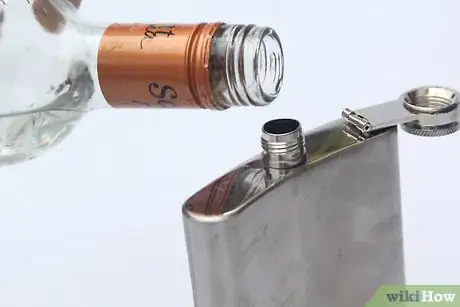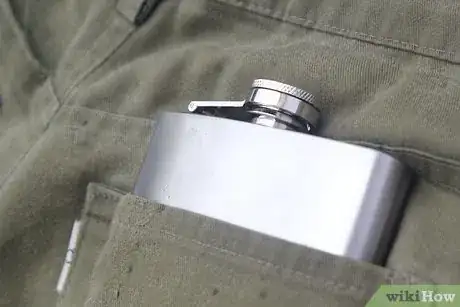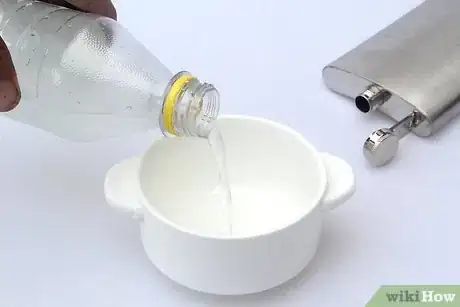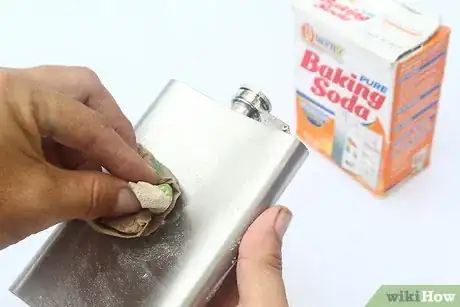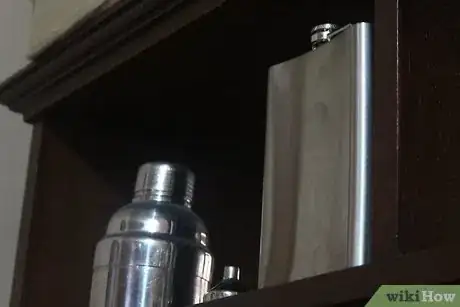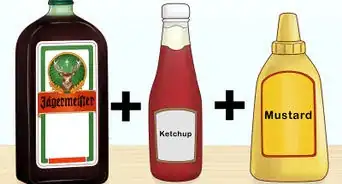This article was co-authored by Bryan Sullivan and by wikiHow staff writer, Megaera Lorenz, PhD. Bryan Sullivan is a Bartender and the Owner of Bryan Sullivan Bartending in Seattle, Washington. With over 10 years of experience, he specializes in craft cocktails and has a thorough knowledge of beer, wine, and champagne. He currently holds a MAST Class 12 Mixologist Permit and has provided bar service for 100s of events. Additionally, his business has a 5-star rating and is a listed vendor on The Knot.
This article has been viewed 76,515 times.
Stainless steel flasks offer a classic and convenient way to enjoy alcohol on the go. There are a few crucial things to keep in mind if you want to keep your flask in good condition and your liquor tasting fresh. Get the most out of your flask by learning what kind of liquor to put in it, and how long to keep it there. Keep your flask in good condition with proper care and cleaning.
Steps
Filling Your Flask
-
1Fill your flask with hard liquor. Flasks are intended for use with straight, undiluted spirits. In general, it is best to fill a stainless steel flask with hard liquors, such as scotch, whiskey, rum, or vodka.
- Avoid adding mixers to your alcohol, since many of these contain corrosive or perishable ingredients that can damage your flask.
-
2Avoid putting corrosive or easily spoiled liquors in your flask. Don’t fill your flask with anything carbonated, acidic, or citrus-flavored. These types of beverages tend to pick up metallic flavors quickly, and can damage the metal of the flask. Do not store cream-based liquors in your flask, as these will spoil quickly if not kept chilled. Beverages to avoid include:
- Beer, cider, wine coolers, and other carbonated beverages
- Wine and champagne
- Cream liqueurs, such as Baileys or Dooley’s
- Citrus liqueurs and other citrus-flavored beverages, such as hard lemonade
Advertisement -
3Use a funnel to fill your flask. Since alcohol flasks tend to have very narrow openings, they can be difficult to fill without spilling. Place the narrow part of the funnel in the opening of your flask. Use one hand to hold the funnel and the flask steady while you slowly pour liquor into the wide opening of the funnel.
- Many stainless steel flasks come with their own funnels for easier filling. Flask funnels can also be purchased at most liquor stores or department stores.
- If you don’t have a flask funnel, any kitchen funnel should do the trick. The main advantage of flask funnels is their small size, which makes them more portable.
-
4Avoid overfilling your flask. To avoid spills and leaks, leave a little space at the top of your flask when you fill it. Fill to just below the neck of the flask. The opening of your flask funnel should allow you to look into the flask and see when it is mostly full.
-
5Keep your flask from overheating. The liquor in your flask is more likely to pick up a metallic taste if it gets too warm. Keep your flask cool by storing it in a jacket pocket or a bag rather than directly against your hip. Avoid leaving your flask any place too warm, such as inside a hot car or in direct sunlight, when there is liquor in it.
- When your flask is not with you, keep it in a cool area away from direct sunlight, such as inside a kitchen cupboard or pantry.
-
6Limit storage time to three or four days. Stainless steel flasks are not intended for long-term alcohol storage. There are no serious health risks associated with drinking liquor that has been stored in a stainless steel flask for a long period of time. However, the longer the liquor remains in the flask, the more likely it is to pick up unpleasant metallic flavors. For maximum freshness, finish off or change out the contents of your flask within a few days, or a week at the most.[1]
- If you’re interested in storing alcohol in a flask for a longer period of time, consider using a glass flask instead of stainless steel.
- The main advantage to stainless steel flasks is that they are light, tough, and portable. Ideally, you should use your flask to store and transport alcohol that you are planning to finish off in a single day.
Caring for Your Flask
-
1Wash a new flask with water before your first use. It’s always a good idea to clean a new flask before filling it with liquor for the first time. While a thorough rinse with hot water is probably sufficient, you may wish to use a little bit of dish soap for the first wash as well. However, take care to use a very tiny amount of diluted soap – just a drop or two – as it can be difficult or impossible to fully rinse the soap out of a flask.[2]
-
2Clean your flask with hot water between uses. If you’re not planning to change the type of liquor you keep in your flask, cleaning with plain tap water between uses is usually sufficient. Boil 2 cups (.5 liters) of water, and carefully pour the water into the flask while it is still hot. Put on the cap and give the flask a good shake for about a minute, then dump the water out.
- Stainless steel will heat up very quickly when you pour hot or boiling water into it. Wrap a dishtowel around the flask or use an oven mitt to keep yourself from getting burned.[3]
- Do not add soap to the water when you clean your flask. It is very difficult to rinse the soap out completely, and the remaining residue will ruin the flavor of your liquor.[4]
-
3Use lemon juice or white vinegar for an extra thorough cleaning. If your flask is in need of a more serious cleaning, or if you want to get rid of any lingering flavors, pour in some lemon juice or distilled white vinegar. Use enough lemon juice or vinegar so that your flask is mostly full, but leave some space at the top (at least ¼ of the volume of the flask) so that you can easily shake the liquid inside. Put the cap on the flask and shake vigorously for about a minute, then pour out the lemon juice or vinegar and rinse with water.
- This type of cleaning is useful if you plan to switch to a new type of liquor. The lemon juice or vinegar will help eliminate any residual flavor from the liquor previously stored in the flask.
- Use only distilled white vinegar to clean your flask. Other types of vinegar may leave lingering flavors.
- Always rinse your flask thoroughly after washing it with lemon juice or vinegar. The acids from these cleansers can damage the flask and affect the taste of your liquor if they are not completely rinsed out. If you still smell lemon or vinegar, give it a second rinse.
-
4Add a mild abrasive to scrub out residue. If your flask is extra dirty, toss in a small handful or 2 tablespoons (30 ml) of coarse salt, rice, or baking soda along with your cleansing liquid. These substances will help scour out any stubborn dirt or residue without being too hard on the stainless steel. Fill up your flask about two thirds full with your cleansing mixture, put the cap on, and shake the flask hard for 30-60 seconds. Dump out the contents and rinse thoroughly with water.[5]
- Baking soda will dissolve quickly and create a fizzy (and potentially messy) reaction when mixed with lemon juice or vinegar. This reaction is not dangerous, but you may wish to stick to mixing baking soda with water if you want to avoid it.
-
5Let your flask dry completely after cleaning. Any time you clean your flask, store it upside-down and uncapped in a drying rack until the inside of the flask is completely dry. Capping a flask that is still damp can lead to mildew or bacterial growth. Once your flask is dry, store it in a cool, dry place, such as a kitchen cabinet.
-
6Finished.
Community Q&A
-
QuestionIs it a good idea to store water and drink from a stainless steel flask?
 Community AnswerIt's fine, as long as no carbonated or acidic drinks have damaged the flask.
Community AnswerIt's fine, as long as no carbonated or acidic drinks have damaged the flask.
Warnings
- Stainless steel can get scratched or corroded easily with improper care. Never wash a stainless steel flask with chlorine bleach or scrub it with an abrasive cleaner or scouring pad.[6]⧼thumbs_response⧽
Expert Interview
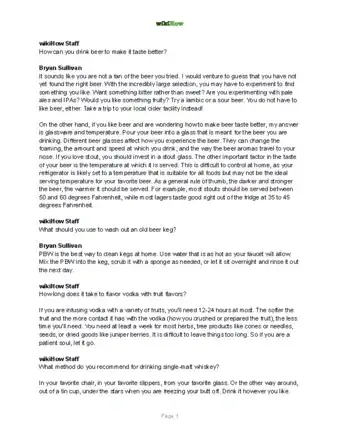
Thanks for reading our article! If you'd like to learn more about alcoholic beverages, check out our in-depth interview with Bryan Sullivan.
References
- ↑ https://www.askmen.com/fine_living/how_to_400/454_how-to-use-a-flask.html
- ↑ http://adequateman.deadspin.com/how-do-i-clean-a-flask-anyway-1708193607
- ↑ http://adequateman.deadspin.com/how-do-i-clean-a-flask-anyway-1708193607
- ↑ https://www.askmen.com/fine_living/how_to_400/454_how-to-use-a-flask.html
- ↑ http://adequateman.deadspin.com/how-do-i-clean-a-flask-anyway-1708193607
- ↑ http://adequateman.deadspin.com/how-do-i-clean-a-flask-anyway-1708193607
About This Article
Stainless steel flasks are great for storing hard liquor when you’re on the go. To fill one, place the narrow end of a funnel into the opening of your flask. Then, slowly pour your alcohol into the funnel until the flask is almost full. Leave a little bit of room so it doesn’t spill or leak as you drink. Just avoid putting beer or anything carbonated inside, since it could damage the metal. You should drink the alcohol within a few days to avoid getting sick. To learn how to clean your flask properly, read on!
